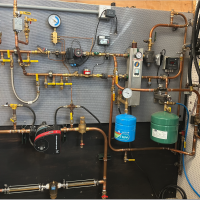Welcome! Here are the website rules, as well as some tips for using this forum.
Need to contact us? Visit https://heatinghelp.com/contact-us/.
Click here to Find a Contractor in your area.
If our community has helped you, please consider making a contribution to support this website. Thanks!
Boiler common venting at the exterior wall
Options
Dave_KC
Member Posts: 22
Is it feasible to combine two boilers exhaust vents into one, at the point of exiting the building through the wall?
I've contacted the manufacturer (HTP UFT-100s), and they will only say to keep within the Approved Vent Lengths:

The boilers are 15' from the wall. Would like to transition the two 2" exhaust lines into one 3" exhaust just prior to exiting the wall. This is a 10" concrete wall, and would rather drill one 3" hole, instead of two 2" holes. Plus it's a little better aesthetically. Would also like to do on the intake side.
I've contacted the manufacturer (HTP UFT-100s), and they will only say to keep within the Approved Vent Lengths:

The boilers are 15' from the wall. Would like to transition the two 2" exhaust lines into one 3" exhaust just prior to exiting the wall. This is a 10" concrete wall, and would rather drill one 3" hole, instead of two 2" holes. Plus it's a little better aesthetically. Would also like to do on the intake side.
0
Comments
-
I'd be OK with it on the intake side -- but not on the exhaust side. But that's my take. You should ask your fire marshall and building inspector.
My reason: if something blocks that exhaust with one boiler running but not the other, all the exhaust will come back through the boiler which is off and into your building. Not the best situation.Br. Jamie, osb
Building superintendent/caretaker, 7200 sq. ft. historic house museum with dependencies in New England1 -
-
Instead of combing exhaust with exhaust, combine exhaust with intake using concentric adapters. This way it's all done proper and you still have only two holes. Albeit 4" holes.
If using PP
Centrotherm ICTCR24 + ICWT242
DuraVent - 2PPS-HKC-N
If using PVC
Diversitech CVENT-2 (any brand.. many make this)1 -
CentroTherm has a combined system that has approvals.
I'm not a huge fan of concentrics, too much recirculation potential.
Is room air a possibility for intake? The installation manual should go into detail about that.Bob "hot rod" Rohr
trainer for Caleffi NA
Living the hydronic dream2 -
Appreciate the comments, thank you. The concentric vent is approved by the manufacturer. Looks like the exhaust recirculation using a concentric has been debated in other threads here before. The exterior wall is facing North, we probably won't use the concentric vent solution.
I did not think using room air was a common practice. I will call our Boiler Inspection dept and see if there is any issue doing this within a residential application.
Per the manual, we would need 10,000 cubic feet of interior space. The utility room is in the basement, with 10 foot ceilings, so 1,000 sq feet. The utility room is not that large, but it would be possible to install vents into the room from some larger areas.
But I'm wondering, isn't there a downside to using room air for the intake? The boilers would be sucking in outside, unconditioned air through cracks in the home envelope which sounds counter productive.1 -
-
I know its tempting, and sounds simple but the guys are on it. Don't do it. Pull your intake from outside...much better job and how they are designed. Its not THAT much more work. Try fishing down 2o foot lengths of 3" PVC and CPVC down old chimneys in attached houses in Queens on steep pitch roofs.in February...Crazy!!! The scariest part is raising it all the way up high to drop down in one long piece..Gets VERY WOBBLY and ya gotta work FAST or your losing the vertical battle and crashing it down on to the Neighbors new Caddy..who happens to be a Local Mafia Caporegime!!!
Ha ha...No pressure now!!!! Glory Days...Mad Dog 🐕 🤣1 -
You want it to inhale the cleanest air. I've had issues with intake are on rural jobs with dirt or gravel parkings lots. Tree pollen has been an issue in some NW locations. Lighting bugs plugged one of mine. These were farm stores so we opted to use the cleaner inside air. Noise was not a concern in their case, plugged HXers were.
Noise could be a concern when pulling inside air as Richard mentioned. The early HTP Voyagers, or maybe it was the Polaris, had a big intake filter option that acted as a silencer also. It looked like a semi truck air filter. Maybe it was The early condensors were an assembly of unique parts. I think the early Voyagers also use a vacuum cleaner fan/ motor assemble. It sure looked like one. Bob "hot rod" Rohr
The early condensors were an assembly of unique parts. I think the early Voyagers also use a vacuum cleaner fan/ motor assemble. It sure looked like one. Bob "hot rod" Rohr
trainer for Caleffi NA
Living the hydronic dream0
Categories
- All Categories
- 87.3K THE MAIN WALL
- 3.2K A-C, Heat Pumps & Refrigeration
- 61 Biomass
- 427 Carbon Monoxide Awareness
- 119 Chimneys & Flues
- 2.1K Domestic Hot Water
- 5.8K Gas Heating
- 114 Geothermal
- 165 Indoor-Air Quality
- 3.7K Oil Heating
- 76 Pipe Deterioration
- 1K Plumbing
- 6.5K Radiant Heating
- 395 Solar
- 15.6K Strictly Steam
- 3.4K Thermostats and Controls
- 56 Water Quality
- 51 Industry Classes
- 50 Job Opportunities
- 18 Recall Announcements




